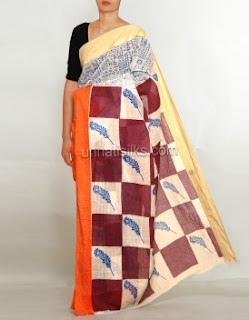Dharmavaram is in Anantpur
district of Andhra Pradesh, India. Known for its handloom industry, Dharmavaram
is a hub for the manufacture and sale of the Dharmavaram Silk Sarees. A household name in South India,
the Dharmavaram Silk Saree is famous for its excellent weaving quality, rich
look and feel.
Dharmavaram Silk Saris also known as Rajwadi Sarees are known for their
broad borders and gold brocade embroidered pallus, available in a combination
of soft colours, exquisite designs and varying patterns.
Sometimes confused with the
Kanchipuram Saree, the difference lies in the patent features of the
Dharmavaram Saree – its muted colours and the double-colour effect of the Saree.
The making of the Dharmavaram
Silk Saree involves a lot of painstaking care and precision.
Desired colour is mixed with
water boiled to a high temperature. Heat causes colour to adhere making it fast
or durable. The yarn is immersed and the water stirred to spread the colour
evenly throughout. The choice of right colour and shade is crucial and the
right combination increases the value of the fabric. The decision hinges on the
designer himself.
The elegance and extra-look that
the Dharmavaram Silk Saree lends, makes it a must-buy and prized possession to
be displayed on special occasions.
The Dharmavaram Temple Pallu Saree has a rich colour combination, with
elegant prints on the fabric additionally adorned by tikkis, stones and crystal
work. It is most-preferred wear for big parties and social occasions.
The Group Buttal Thandu Dharmavaram Saree is a unique for employing
different fabrics, threads and decorative items. Handwork and embroidery are
worthy additions to the Saree. It has an excellent finishing and is very
comfortable to wear.
A trending version is the Dharmavaram Pattu Silk Sari with attractive
designs as peacock feathers, Brahmakamalam, shine of the stars added to the
multi-coloured threads giving the changing colours effect. It is appropriate to
wear for college parties, corporate functions, or social get-togethers like
weddings and special invites.
Unnati Silks, devoted to ethnic sarees
and salwar kameez materials, has a wide range of Dharmavaram Silk Sarees. Incorporating traditional and trendy
designs in the most attractive colour combinations they cater to varying
individual tastes and at the most reasonable prices.
















































